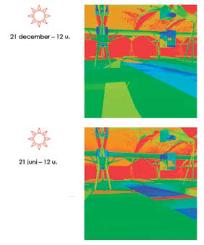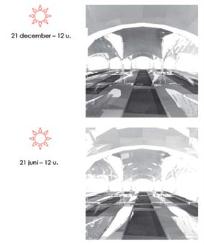SEO Version





53
at 12am, and June 21st at 12am. These four extreme cases provide objective points
of comparison to evaluate the proposed system.
Radiance calculates the luminosity of any given surface. The black and white figures
render the simulated light conditions quite accurately by means of a spectrum
ranging from black (zero luminosity) to white (high luminosity). Since luminosity is
the only photometric value visible to the human eye, these simulations allow simple
observations of the experienced visual impression of the station’s lighting ambient.
The colour figures render the transposition of the lighting levels of any given surface.
Thismeans that a dark surface will indicate a lower lighting level than a white surface,
even if both surfaces receive the same amount of light. This explains why, in the
presented figures, the floors are less illuminated than the lower part of the columns
which are sunk into them, or why the dark-coloured elevator shafts seem sparsely
lit. The lighting values of the station need to be measured on structures and vaults
whose white colour does not influence the given lighting conditions.
Figures 1, 2, 3 and 4 present the actual solution. They represent the situation at the
centre of the canopy and underneath the footbridge. The more the colour of a wall
appears dark blue, the less bright its surface is. The more it appears red, the brighter
it is.
According to these four perspectives, the light is well dispersed throughout the
space and the ambient light changes little over the course of time. We point out that
the light dispersion levels are nearly identical for both covered sky situations: only
the intensity of the lighting changes in function of the season. This is due to the fact
that a covered sky only allows diffuse light to pass through. In this case, all glass
openings catch the light in the same way, regardless of their orientation.
Figures 5, 6, 7 and 8 give us a good impression of the future visual conditions in
the station. They give a clear example of the created lighting atmosphere. The first
observation point is located on one of the central platforms; the other coincides
with the view from the footbridge.
The view from
the footbridge is interesting for the examination of the play of light
inside the station. The sunlight variations interact with the volumetry of the station
to create ever changing lighting compositions. The station is the instrument of
the play of light. The twin arches that support the vaults are illuminated by a vast
bundle of light. A well-lit surface creates a stronger figure.
Strong illumination draws attention to the structures of the building. The light
reflected by the canopies illuminates the basis of the bearing points intensely. This
sequence emphasises scale and creates an impression of lightness. The peripheral
canopies of the roof seem lighter than the ones at the centre of the station cover.
The edges of the building seem blurred; daylight creates the link between inside
and outside.
Figures 9 and 10 compare the use of reflective glass to standard clear glass as
surface material for the inside canopies. The reflecting glazing of the canopies
casts the light towards the ceiling. The reflected light emphasises the shapes of
the roof.
The last two selected views figures 11 and 12 show the abundance of light in the
footbridge area. The viewpoint was located at one of the wall fronts. The grey floor
indicates an adequate lighting level, even on December 21st, the gloomiest day of
the year, under a covered sky.
without
light refecting glass
fig. 8
fig. 10
fig. 12
fig. 7
fig. 4
fig. 3
Powered by FlippingBook Publisher

